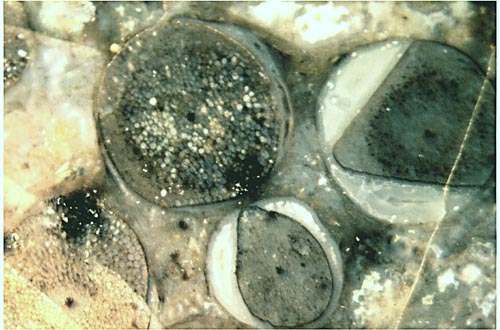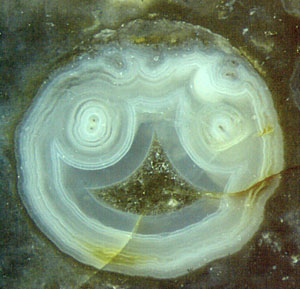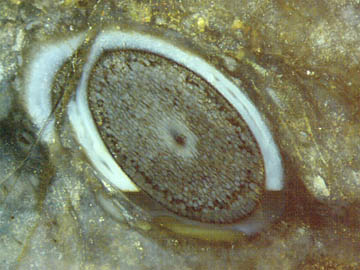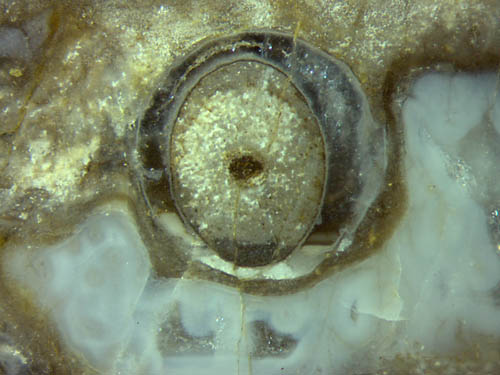Sequence
of silicification stages deduced from plant sections in chert
Various details seen in fossiliferous
cherts and petrified wood may reveal something about the multi-stage
fossilisation process. There is lots of evidence suggesting that
silicification was not simultaneous everywhere: Some areas had turned
into silica gel while others were still fluid, which can be deduced
from the presence of wide cracks in the former gel suddenly ending at
the former boundary between gel and fluid.
Other evidence of the co-existence of gel
and water at early stages of the silicification process is provided
by
sections of shrunken plants occasionally seen within the contour of the
live plants (Figs.1,3,4). See also Rhynie
Chert News 31.

Fig.1: Circular contours of live Rhynia
in chert, therein sections of Rhynia
shrunk while decaying in the water-filled cylindrical cavity before
becoming silicified. Width of the picture 3.5mm.
The super-saturated silica-rich water flooding the stands of early land
plants [1] may turn into silica gel soon but the cuticle on the
epidermis serving as a diffusion barrier can greatly
delay the silicification of the inundated plants.
With most of the available silica being
bound into the surrounding gel, much time can pass before the remaining
dissolved silica has moved by diffusion through the pores in the
cuticle of the
decaying and shrinking plant in such amounts that gel is formed inside
the plant, whereupon shrinkage stops. The influx of silica can be so slow that decay does not stop before the
plant has vanished, leaving a cavity in the gel shaped like the live
plant (Fig.2).

Fig.2: Cross-section of a cylindrical mould
of Aglaophyton
in Rhynie chert, 2.3mm, once water-filled and occupied by
aquatic fungi
after complete decay of the plant and before silicification of the
cavity which once had been the plant. Note the
layered silica coatings deposited along the wall and around the fungus
hyphae.
There is another conspicuous silicification phenomenon
proceeding in water-filled cavities, which is related to degradation
and shrinkage of tissue only because the latter provide cavities. While
the plant tissue degrades and shrinks away from its cylindrical
contour, it is replaced by water and dissolved silica entering by
diffusion. The silica may not form gel
throughout as it did with high supersaturation. Instead, it may form
clusters so large that they are not kept afloat by thermal motion but
settle down into a heavy suspension with a level interface sooner than
colliding with a wall and getting stuck there. This may happen with or
without a shrunken plant in the cavity. The final stage of the process,
with shrunken plant, suspension, and water turned into solid chalcedony,
is seen in Fig.3. Unlike the situation in Fig.1, the shrunken shoot is
still cylindrical here. The resulting cylindrical gap became filled
with
water and silica suspension turning into gel and finally into milky and
dark chalcedony. The discontinuity above left
is
due to fracture and subsequent displacement out of the cut plane 
Fig.3
(right): Inclined section of Rhynia
(?)
flattened by flooding, well preserved with ring of dark
cells with
symbiotic fungus but shrunk away from its cylindrical enclosure
of 2mm width.
Note the deposit with two level interfaces at the bottom
of the cylindrical gap, which had been silica suspension at
some stage of silicification, stained dark
possibly by organic admixture.
Fig.4 (below): Cross-section of Horneophyton
(?) flattened
by flooding with silica-rich water turning into silica gel, thus
forming a cylindrical enclosure of 2.5mm
width, from which the plant shrunk away owing to
rot. Note the whitish
deposit at the bottom with levels
of unequal height.

What is now seen as bluish chalcedony had been a swamp gas bubble
pushing on the inundated live plant. Obviously it did push no more
while the
meanwhile dead and decaying plant shrunk away from its enclosure,
otherwise it would have followed the contour of the shrinking plant.
Hence, some time must have elapsed between flooding and shrinking.
The bubble must have become filled with silica-rich water by
diffusional outflow of gas and inflow of water. Apparently the water
had been teeming with microbial life. A thick layer of microbial slime
had grown in the water along the boundary of the water-filled cavity.
Subsequently, silica gel must have been deposited in the former bubble,
which had not been a one-step process, as can be concluded from the two
small cavities below, which persisted for a while between the gel until
silica clusters settled into an suspension separated from the water above
by a level boundary. (Much later, crystalline quartz grew in the
remaining water.) In a first step the microbial layer seems to have
turned into gel, now seen as a brown-stained chalcedony layer.
Similar as with Fig.3, of particular interest is here what happened in
the water-filled gap between the silica gel mould of the live plant,
circular in Fig.4, and the not yet silicified shrinking plant.
As explained above, silica clusters accumulate at the bottom of the
gap. The resulting suspension with two level interfaces, left and right,
eventually solidifies. Hence, newly formed suspension finds itself in
separate compartments and makes levels whose heights are not
correlated. While the latter suspension, too, solidifies, the plant
shrinks further and separates from the layer, leaving two tiny gaps
hardly visible in Fig.4.
Shrinkage
stops as soon as the decaying plant is stablized by silica gel. The
silica solution in the cavity or gap surrounding the shrunken plant
may still be fluid by that time but the continuing slow diffusional
inflow of dissolved silica and outflow of water turns the shrunken
plant and the deposit into chalcedony and give rise to the growth of
coarse-crystalline quartz until the gap is filled. The clear quartz
crystals let the incident light pass into depth and therefore look
dark.
As
usual with the chert fossils, some questions are left unanswered. The
different aspects, with whitish chalcedony at the top in Fig.3 but
at the bottom in Fig.4, may be confusing. Also one may wonder why
quartz forms in some cases (Figs.2,4) but not in some others
(Figs.1,3). Coarse quartz is usually said to be the last formation in
the silicification series, as it doubtless is in Figs.2,4, but there is
contrary evidence from petrified wood: Occasionally, mm-size crystals
may come first, chalcedony later. See Fossil
Wood News 1.
Samples:
Rhynie Chert (Lower Devonian). Fig.1:
Rh7/21.1 (2003) 2.2kg
Fig.2: Rh12/154 (2007)
0.11kg
Fig.3: Rh2/71.2
(2001) 3.22kg
Fig.4:
Rh12/123.1 (2006) 0.27kg
H.-J.
Weiss 2014
2019
[1]
N.H. Trewin : The Rhynie cherts: an early Devonian
ecosystem preserved by hydrothermal activity.
Scott. J. Geol. 28(1992), 37-47.
 |
 |
59 |







